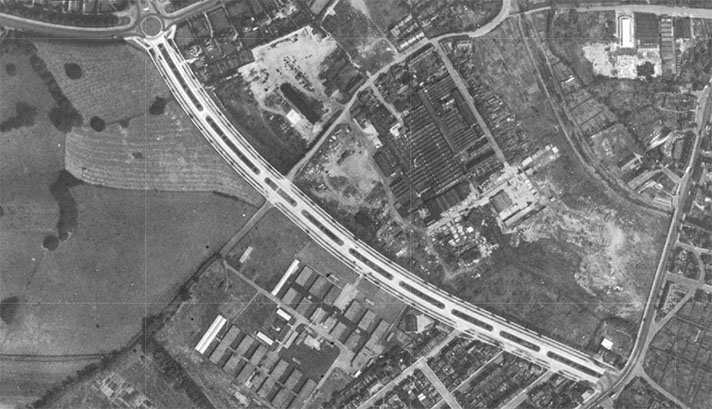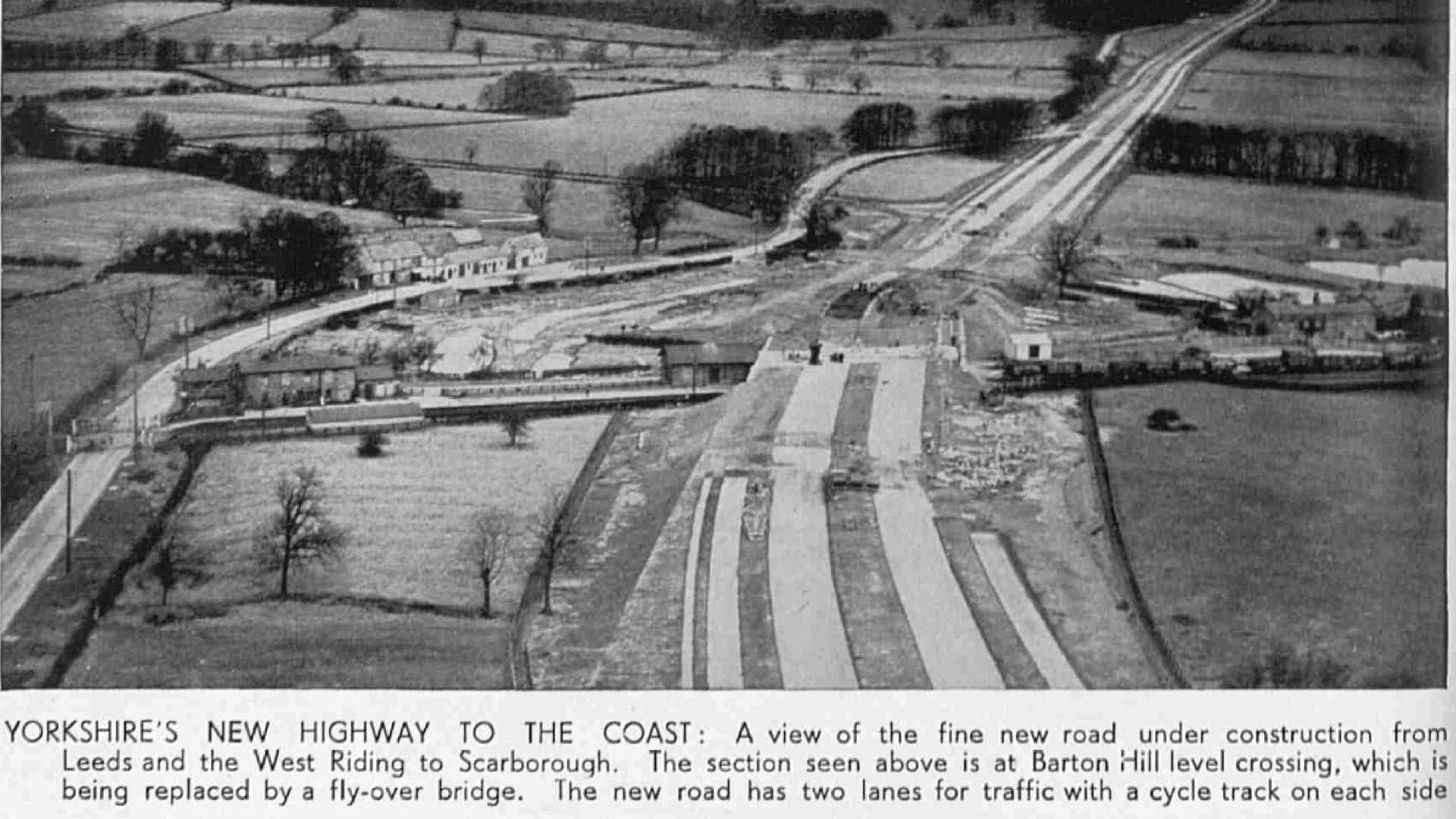
Photo from The Sphere, April 1937.
There’s a 1930s cycle track on the A64 York to Malton Road. It’s between Barton Hill and Whitwell-on-the-Hill. There’s also a possible period cycle track or footway stretching almost 22 miles (36 kms) from Malton almost to Scarborough.
The dual carriageway between Barton Hill and Whitwell-on-the-Hill is 3.41 miles long, or 6,000 yards; there’s a dual-sided cycle track on the whole stretch. However, a 1937 letter from the MoT to the American Embassy in London says the A64 cycle track at this point is 4,300 yards long, or 2.44 miles. The discrepancy cannot be explained; the on-the-ground evidence carries more weight.
The MoT’s letter also states that the 9-ft-wide cycle tracks were surfaced with asphalt.
The width appears accurate but an aerial photograph, dated 1937, shows the road, cycle track and footway are each made with concrete, and period writers also described the track as concrete.
The 1937 photograph, published in The Sphere, states that the “fine new road” is “Yorkshire’s new highway to the coast.” The magazine’s motoring correspondent A. Percy Bradley added that the “new road has two lanes for traffic with a cycle track on each side.”
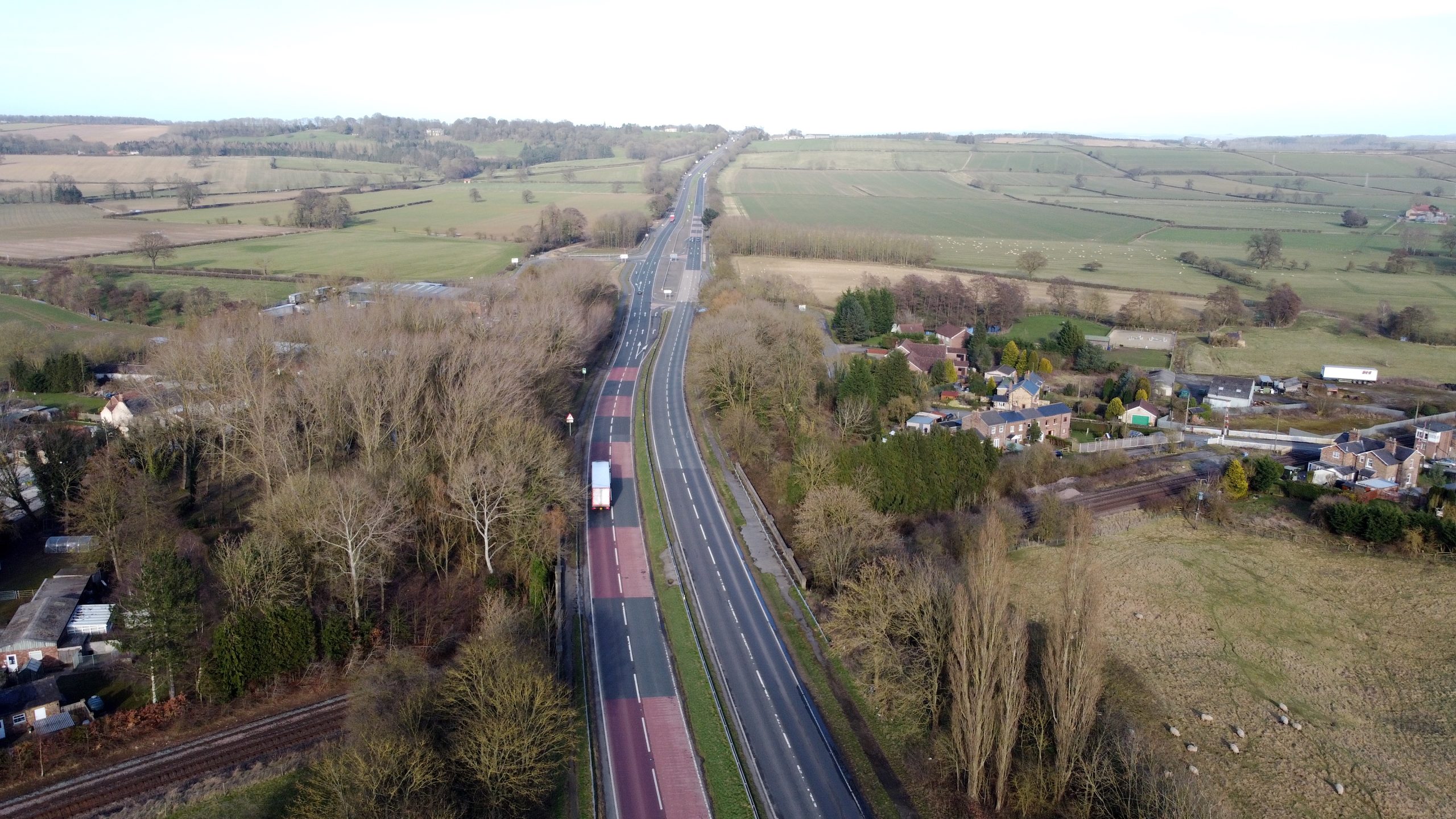
The A64 was elevated over the rail track at Barton Hill in 1937, and cycle tracks added. The footways have been lost.
Frank Snape, motoring correspondent of the Leeds Mercury, argued in April 1937 that the “ideal road of the future … will consist of two roads, with separate up and down tracks, well divided either grass verge or a hedge, with special tracks for cyclists (again both up and down), and footpaths for pedestrians.”
He told his readers that a “section of a road of this new kind can be seen by Yorkshire motorists between York and Malton.”
Another newspaper reported that on 2 November of that year, “Mr Burgin [minister of transport] will pass along the new stretch of dual carriageway road with cycle tracks between Malton and York …”
In June 1938, a journalist “observed a curious thing” on the road.
“Although this road is provided over a great part of its length with a concrete cycle track,” he stated, “I noticed quite a number of cyclists still using the motor road. One of them trudged up a steep gradient, walking his machine, and using the fast traffic lane! That struck me as very queer — perhaps some cyclist can offer a charitable explanation.”
That journalist clearly hadn’t been paying attention to the local news because during the previous year there had been many local media reports on protests against the cycle tracks by members of national cycling organisations.
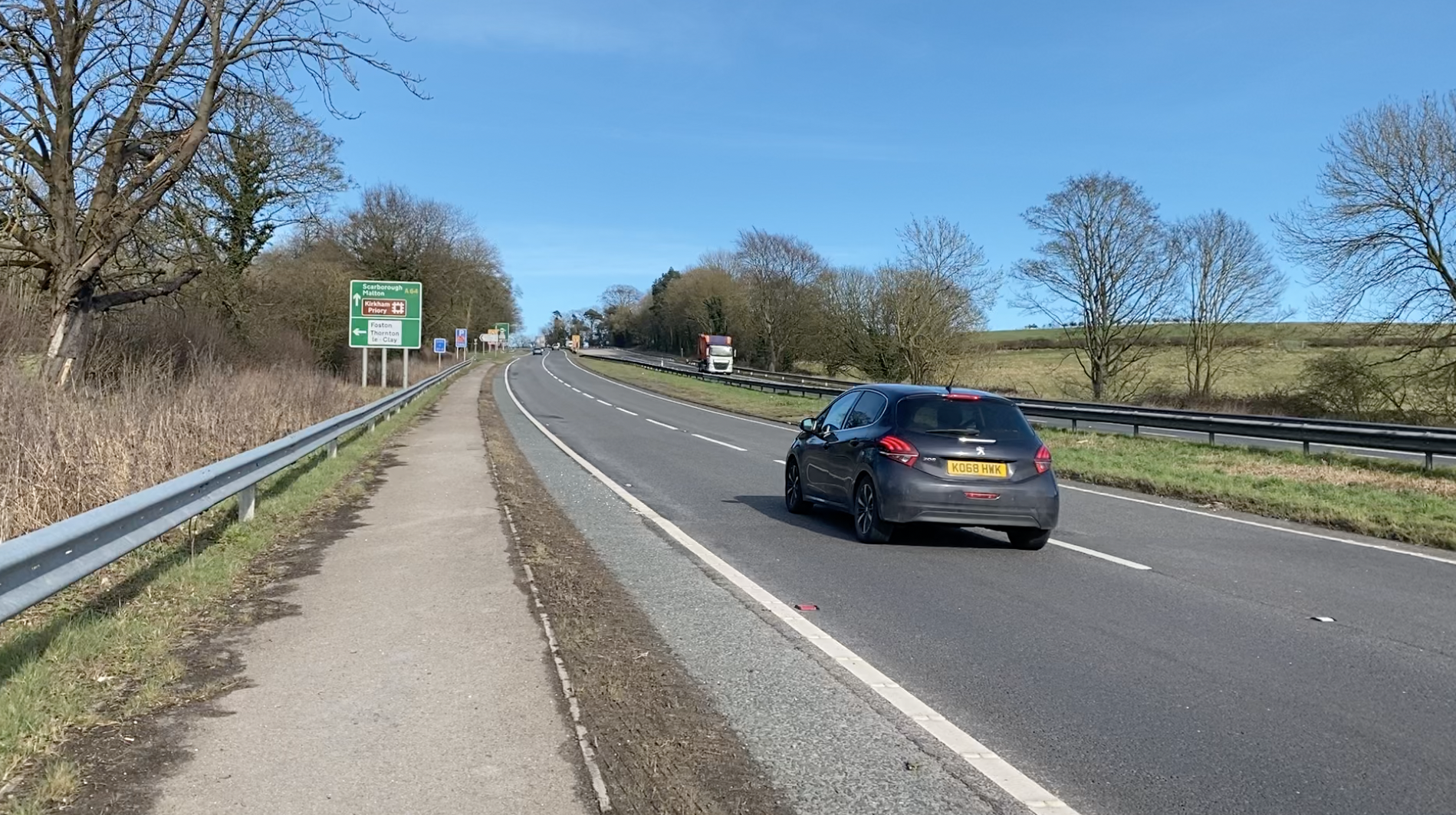
No protection on this part of the A64 cycle track.
Under the headline, “Cyclists Plan Coast Road Traffic Jam,” the Yorkshire Evening Post in May 1937 reported that a “mass ride” was being arranged as “protest refusal to use special tracks between York and Malton.”
The demonstration, said the paper, was being arranged by local chapters of the Cyclists’ Touring Club.
“The cycling tracks extend for several miles on a section of road which has been reconstructed with double carriageways and separate cycle tracks [to] facilitate traffic between the West Riding and the Yorkshire Coast,” continued the article.
Mr. C. A. Pratt, secretary of the CTC’s Hull and East Riding Association told the newspaper of the “folly and danger” of the tracks and said that “cyclist pickets should be stationed at the end of the paths each week-end to distribute literature urging cyclists not to use them.”
North Riding County Council’s county surveyor Mr. R. Sawtell told the Yorkshire Evening Post that “the County Council has been generous to cyclists in the provision of tracks on this section of road.”
“The Ministry of Transport,” he continued, “laid it down that we should provide tracks six feet wide. We have made the tracks nine feet wide.”
He then explained the rationale for building such tracks:
“The provision of cycle tracks is the declared policy of the Minister of Transport. The County Council is forced to accept that ruling if it is to obtain grants for the reconstruction of classified roads where there is a reasonable weight of cyclists.”
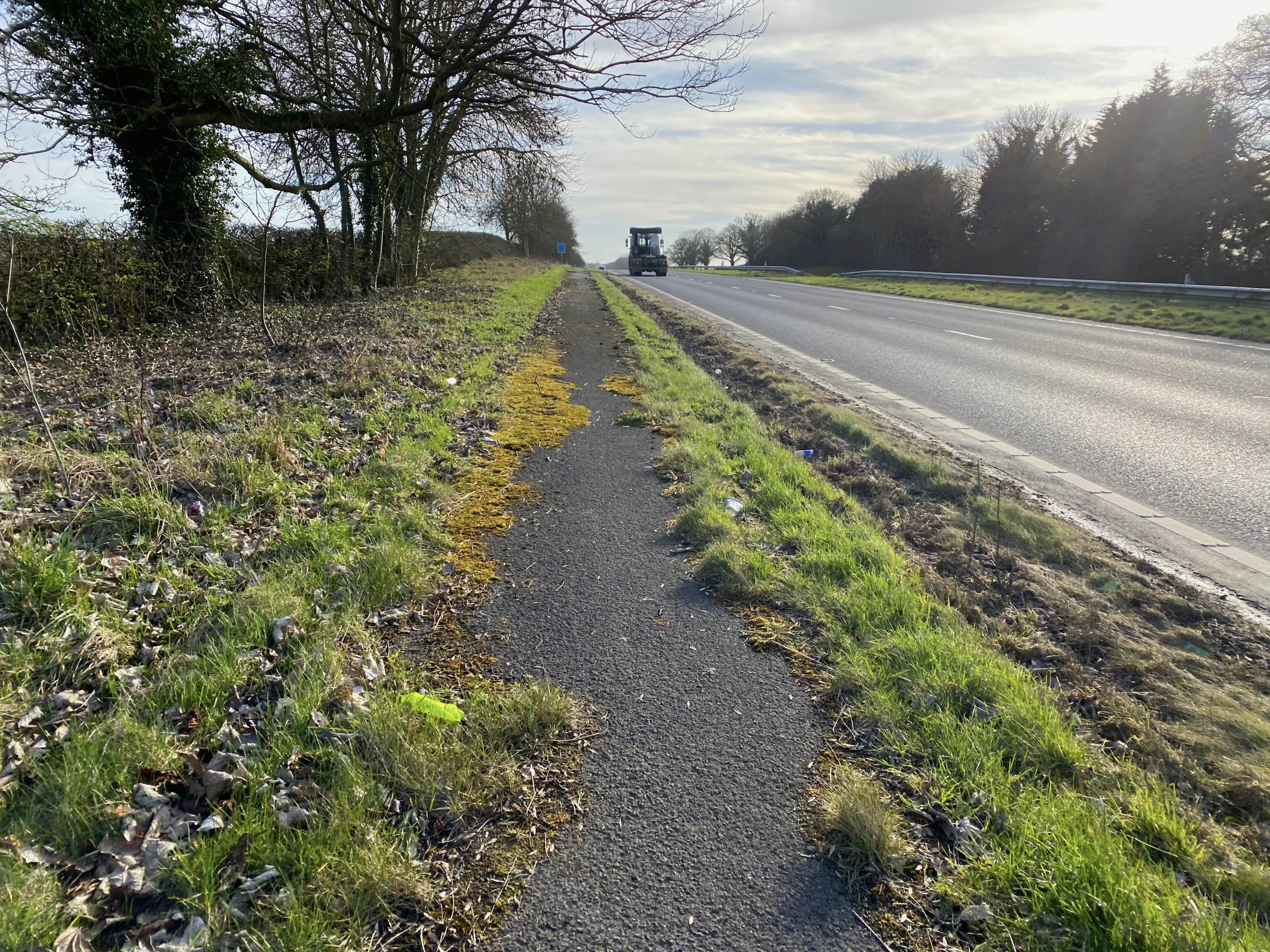
The A64 cycle track is neglected in some sections.
The Barton to Whitwell cycle tracks were excellent, he stressed.
“We have done everything possible to make the tracks beyond the criticism of cyclists.”
“Organised” cycling may not have liked the new tracks, but everyday, non-club cyclists were not opposed to them, described a Yorkshire Evening Post reporter in June 1937.
Labelled by the paper as “a cyclist,” the unnamed reporter said the tracks were signposted: “Representations in black, on a white-enamelled background, of a very sedate roadster bicycle, with the words ‘Cyclists Only’ mark the points where the cycle paths diverge from the road,” he wrote.
“The first user of the cycle path that I saw was a policeman who sailed majestically from the road into the mouth of the path and spread himself comfortably in the middle of its three yards width. The next bunch … was a double file bunch of about six singles and a tandem pair. The six singles swept by the entrance to the path, ignoring the invitation, and continued along the motor road. The tandem pair chose the track.
“The rear quartet of cyclists, in 100 yards or so, sensed they had lost the tandem riders, and then spotted them on the cycle path. They apparently had not seen the path until then! They dismounted, crossed the grass verge to the path, and gave it a trial. The two leading cyclists continued to ignore the path, a procedure which deeply agitated about one in every 10 motorists, judging by the flourishing of arms from car windows as they passed.”
He described the path’s width as “generous” as he and his riding companion had “ample room to ride abreast.”
He calculated that “about 80 per cent of cyclists were using the paths, notwithstanding the opposition that has been raised to them.”
The correspondent and his companion turned off the track to visit Kirkham.
“This involved going on the up motor track, riding it along for 100 yards or so to the opening to the down motor track, and a similar distance along this track before we could escape into the Kirkham Lane.
[Crossing, probably: https://goo.gl/maps/sJhntwrESjuDHKS27]
“The crossing taught us that at road junctions like this, the cycle path ceases to be a complement of the entire road, and becomes, in effect, a minor road joining up with the motor road,” the journalist concluded.
However, he stated the standard criticism of the 1930s tracks: that they threw the cyclist into the maelstrom of traffic:
“Care will have to be taken by cyclists at each end of a cycle track where it bring them — at an angle — into the road used generally by all traffic.”
Despite this design flaw, motorists praised the cycle tracks. In 1939, Snape of the Mercury described a journey between York and Malton, saying that “cyclists were making good use of their tracks.”
He was “particularly struck” he said, “by the attitude of the cyclists in view of the outcry their organisations so mistakenly raised when tracks were first proposed.”
“On Saturday and Sunday hundreds of men and women were cycling happily and safely on the tracks, and I saw only one instance in my two journeys of a man preferring the rougher and more dangerous motor-way,” he described.
“New roads of this type are a rare boon alike to motor drivers, cyclists and walkers, and I hope the day will soon come when all main roads will be so transformed.”
The Barton-to-Whitwell cycle track did not continue to Malton although, in 1938, there were many newspaper reports of a forthcoming bypass of the town which would include cycle tracks. This bypass did not get built until 1979.
East of Malton there are traces of tracks usually on one or other side of the A64, and almost extending for 22 miles. There are no period sources discussing the construction of such long lengths of cycle track on this single carriageway road but, then, nor are there any sources discussing the construction of footways, either.
The cycle tracks/footways on this section of the A64 can be seen on Google Streetview, including at Ganton — https://goo.gl/maps/7RQCkWmYvdQm5U149 — where there are tracks both side of the road, one of which is split in two.
There are also overgrown remnants of tracks/footways on those parts of the period A64 that were later straightened or bypassed, such as at Scagglethorpe, West Knapton, West Heslerton, Brompton Lodge, and Willerby.


